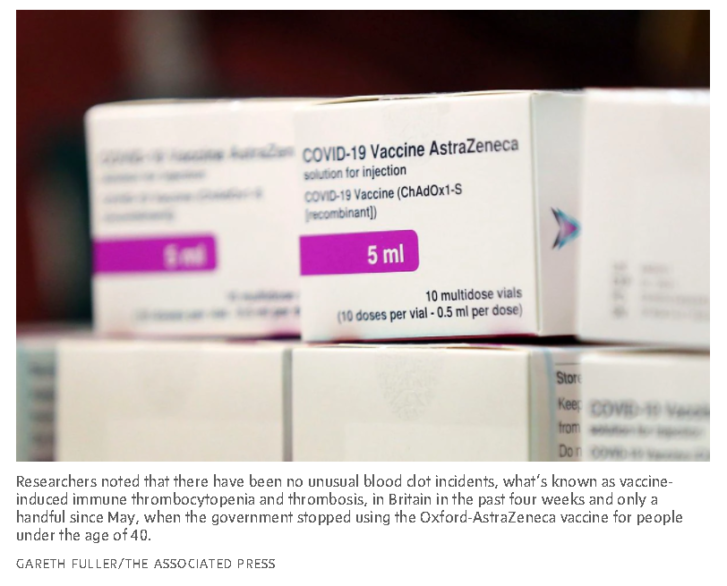Researchers in Britain have concluded that there is a direct link between the Oxford-AstraZeneca vaccine and unusual blood clots, but they’ve insisted that the cases remain extremely rare and that Britain has seen virtually no incidents since health officials restricted use of the COVID-19 vaccine to older people.
The study was led by Oxford University Hospitals and it involved a team of hematologists from across Britain. They examined 220 cases in Britain of what’s known as vaccine-induced immune thrombocytopenia and thrombosis, or VITT.
The researchers concluded that all of the cases were linked to a first dose of the AstraZeneca vaccine and they noted that there have been no VITT incidents in Britain in the past four weeks and only a handful since May, when the government stopped using the shot for people under the age of 40.

The vast majority of VITT patients – 85 per cent – were younger than 60 and the median age was 48, according to the study, which was published Wednesday in The New England Journal of Medicine. Of the 220 cases, 49 people died.
“When we analyzed our definite and probable VITTs it turned out that every single one of those 220 cases followed the first dose of the AstraZeneca vaccine,” said Sue Pavord, a consultant hematologist at Oxford University Hospitals who led the research team. “We are all completely confident that VITT is a response to the AstraZeneca vaccine.”
She added that the researchers had not found a confirmed case of VITT in people who’d had a second dose of the vaccine or in anyone who’d been immunized with the Pfizer-BioNTech jab. “We have no convincing evidence ourselves that we have seen definite or probable cases of VITT after the Pfizer vaccine,” she said.
Dr. Pavord stressed that incidents of the clotting were rare – 1 in 50,000 for people under 50, and 1 in 100,000 for those over 50 – and that vaccination remained a critical tool against COVID-19.
She added that the team has come up with a five-point criteria to help physicians around the world identify VITT and treat it. Early treatment, including a blood plasma exchange, can increase the survival rate by as much as 90 per cent in some cases, the study said. “If they can recognize this condition early, manage it promptly and manage it well, then it allows the vaccine rollout to continue in their countries,” Dr. Pavord said.
Concerns about clotting emerged in March after health officials in several countries reported multiple cases of cerebral venous sinus thrombosis, or CVST, in people who had been vaccinated with the AstraZeneca shot. CVST is a sometimes fatal condition that occurs when clots form in veins that drain blood from the brain. The vaccine had also been tied to other clotting events that were coupled with low platelets, which can lead to heavy bleeding. Around 40 people in Canada have developed signs of VITT and five have died.
Several countries, including Canada, have limited the use of the vaccine to people over 40 or 50.
Dr. Pavord said the research team has learned far more about the condition. They discovered that the clotting went beyond CVST and appeared throughout the body – in veins and arteries connected to the brain, liver, spleen and lungs. The mortality rate can range from 22 per cent to 73 per cent in severe cases and the condition tends to show up within two weeks of the first dose, she added.
The group also found that most of the people who contracted VITT had no previous medical illness and no predisposition to blood clots. “What this study says is that this can affect anybody,” said Beverley Hunt, a professor of thrombosis and hemostasis at King’s College London who participated in the research.
Dr. Hunt said one patient, a woman in her 40s, was totally healthy before she had the AstraZeneca vaccine. Within 14 days she developed severe headaches and was admitted to hospital with a low platelet count. “Her level of consciousness deteriorated very quickly and despite early treatment she died,” Dr. Hunt said.
Another case involved a man in his 40s whose legs went numb less than a week after his first dose. “When he was examined he had no pulses in his legs,” she said. He survived after two operations to clear the clots.
Scientists still aren’t clear what causes the clotting or why young people are more vulnerable. Studies have shown that VITT is similar to a condition that occurs infrequently with a blood thinning drug called heparin. The condition is known as heparin-induced thrombocytopenia, or HIT. In the case of HIT, the negatively charged heparin molecules bind to a positively charged protein called platelet factor 4 which is important for clotting. Some people produce antibodies against that combination which causes out-of-control clotting. Platelets are consumed in the process of forming clots, which ultimately causes a low platelet count.
Michael Makris, a professor of hemostasis and thrombosis at the University of Sheffield in England, said some components of the AstraZeneca vaccine were also negatively charged which could be why it causes a similar reaction. Scientists are also studying a possible genetic link to the condition which could help to identify people who should not receive the AstraZeneca vaccine.
Article From: Globe and Mail
Author: PAUL WALDIE

